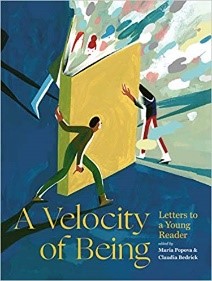Ellen Ryan
January 2020
Book Review

Maria Popova and A Velocity of Being
A Velocity of Being: Illustrated Letters to Children about Why We Read by 121 of the Most Inspiring Humans in Our World (2017), edited by Maria Popova and Claudia Bedrick.
A collection of invited letters to the children of today and tomorrow about why we read and what books do for the human spirit, composed by well-known writers and other creative artists, scientists, adventurers, e.g., Toni Morrison, Elizabeth Gilbert, Jane Goodall, David Whyte, Yo-Yo Ma, Ursula K. Le Guin, Mary Oliver, Neil Gaiman, Amanda Palmer, Rebecca Solnit, Anne Lamott, Diane Ackerman, Judy Blume, Elizabeth Alexander, Adam Gopnik, Dani Shapiro, Ann Patchett, a 98-year-old Holocaust survivor, Italy’s first woman in space, etc. They write about how a life of reading shaped their very identity and future.
The format places a one-page letter opposite a full-page specifically commissioned illustration in vibrant colour. Many of the beguiling illustrations can be viewed at the above website. All proceeds go to the New York City Public Library to support the habit of reading.
Maria Popova (born in 1984) grew up in communist Bulgaria. She writes that she was saved by reading in her great grandfather’s library during many childhood hours. Having emigrated as a college student to the US, she lives in Brooklyn where she met her co-editor for the book, owner of the Enchanted Lion Press. Her blog (BrainPickings.org) analyzes and synthesizes literature (classical and current), linking themes to the visual arts, science, and philosophy. What she calls a “human-powered discovery engine for interestingness” has more than a million followers.
These letters are Legacy Letters, what Rachael Freed suggests we adults learn to write frequently to younger recipients, using life stories to pass on life lessons and values we hold dear. [Freed, R. (2013). Your legacy matters: A multi-generational guide for writing your ethical will. Minneapolis MN: Minerva Press. https://www.life-legacies.com/ ]
An intriguing variety of forms of address are employed. Consider the implications of addressing a letter in these different ways: Dear Young Reader, Dear Friend, Dear You, Dear Young Explorer, To Open Minds of Tomorrow, To the Future of Humanity, Dear Book Lover.
Some letters, or parts of letters, are more memorable than others. Personal anecdotes about childhood reading experiences form the core of the best letters. So many writers (including Mary Oliver, Jane Goodall, Dani Shapiro) survived aloneness and/or family troubles by reading under the covers with a flashlight, nestled in trees or sitting with back against one, while walking friendless to school, and Saturdays in the library. David Whyte wishes he were in a child’s shoes now so he could be at the beginning, so he could encounter his favorites for the first time. Scolded for being antisocial because he read all the time in childhood, David Ulin says, “Reading taught me everything I know about the world.” Through books, readers learn who they are and learn about ‘the other’– how they think, what they feel, how what they say sometimes does not mean what they meant, how a stranger becomes a friend.
We book lovers can savor these illustrated messages from fellow enchanted readers and also discover ways to write (and perhaps illustrate) our own legacy letters.

